Brown and White Baby King Charles Spaniel Coloring Pages That You Can Color
| Condescending King Charles Spaniel | |||||||||||||||||
|---|---|---|---|---|---|---|---|---|---|---|---|---|---|---|---|---|---|
 Blenheim Cavalier Male monarch Charles Spaniel | |||||||||||||||||
| Origin | England | ||||||||||||||||
| |||||||||||||||||
| |||||||||||||||||
| Dog (canis familiaris) | |||||||||||||||||
The Cavalier King Charles Spaniel is a modest breed of spaniel classed in the toy group of The Kennel Club and the American Kennel Club[ane] that originated in the Great britain. Since 2000, it has grown in popularity in the Usa and ranks equally the 17th nearly popular pure-brood in the United states.[2] It has a silky, smooth coat and normally a shine undocked tail. The breed standard recognizes 4 colours: Blenheim (chestnut and white), tricolour (black/white/tan), black and tan, and ruby.[ane] The breed is generally friendly, placid, and proficient with both children and other animals; notwithstanding, they require much human interaction. Since they are family dogs, it is recommended to not leave 1 alone for long periods at a time. The expected lifespan of a Cavalier Rex Charles Spaniel is between nine and 14 years.[3]
The Cavalier King Charles changed dramatically in the tardily 17th century, when it was interbred with flat-nosed breeds. Until the 1920s, the Condescending shared the aforementioned history as the smaller Male monarch Charles Spaniel. (Information technology is to be noted that the King Charles Spaniel, also known as the English language Toy Spaniel, is a completely split brood than the Cavalier Male monarch Charles Spaniel.) Breeders attempted to recreate what they considered to be the original configuration of the breed—a domestic dog resembling Charles II'due south King Charles Spaniel of the Restoration. During that period, Cavaliers were the king's supporters.[4] [5]
History [edit]
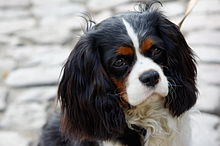
Cavalier Male monarch Charles Spaniel; lesser stop; skull not inclined to exist domed with spot in centre of skull on the Blenheim. A white blaze betwixt the eyes is standard of the Tricolour diversity.

Right Ruby Cavalier King Charles Spaniel; uniform chestnut colour, with no white markings; ears and slippers are oft slightly lighter but dark chestnut colour should predominate
During the early part of the 18th century, John Churchill, 1st Duke of Marlborough, kept red and white King Charles type spaniels for hunting. The duke recorded that they were able to proceed up with a trotting horse. His manor was named Blenheim in honor of his victory at the Boxing of Blenheim. Considering of this influence, the ruby-red and white variety of the King Charles Spaniel and thus the Cavalier Rex Charles Spaniel became known as the Blenheim.[6]
Attempts were made to recreate the original Cavalier King Charles Spaniel as early as the turn of the 20th century, using the now extinct Toy Trawler Spaniels. These attempts were documented past Judith Blunt-Lytton, 16th Baroness Wentworth, in the book "Toy Dogs and Their Ancestors Including the History And Management of Toy Spaniels, Pekingese, Japanese and Pomeranians" published nether the name of the "Hon. Mrs Neville Lytton" in 1911.[vii]
Divergence from King Charles Spaniel [edit]
In 1926, the American Roswell Eldridge offered a dog show class prize of twenty-five pounds of sterling silverish each as a prize for the best male and females of "Blenheim Spaniels of the old type, as shown in pictures of Charles Ii of England'southward time, long face, no stop, flat skull, not inclined to be domed, with spot in center of skull."[8] The breeders of the era were appalled, although several entered what they considered to be sub-par Condescending King Charles Spaniels in the competition. Eldridge died before seeing his plan come up to fruition, just several breeders believed in what he said and in 1928 the offset Cavalier society was formed.[8] The first standard was created, based on a dog named "Ann's Son" owned by Mostyn Walker,[9] and the Kennel Gild recognized the variety equally "King Charles Spaniels, Cavalier type".[8]
The Second World War caused a desperate setback to the emerging brood, with the vast bulk of breeding stock destroyed because of wartime hardship and food shortages. For case, in the Ttiweh Condescending Kennel, the population of sixty dogs dropped to three during the 1940s.[x] Post-obit the war, few dogs survived every bit the new beginning from which all present-day Cavaliers descend. And in 1945,[11] the Kennel Club starting time recognized the brood in its ain right as the Cavalier Rex Charles Spaniel.[eight]
The history of the brood in America is relatively recent. The first recorded Cavalier living in the United states was brought from the United kingdom of great britain and northern ireland in 1956 past W. Lyon Brown, together with Elizabeth Spalding and other enthusiasts, she founded the Cavalier Male monarch Charles Society USA that continues to the present 24-hour interval. In 1994, the American Condescending King Charles Spaniel Society was created by a group of breeders to apply for recognition by the American Kennel Guild. The Condescending would go on to exist recognized by the American Kennel Club in 1995,[1] and the ACKCSC became the parent club for Cavaliers.[12]
Description [edit]
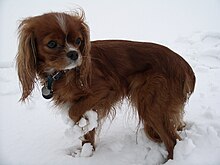
Ruby Cavalier in the snow
Historically the Cavalier Male monarch Charles Spaniel was a lap dog and is small for a spaniel, with fully grown adults comparable in size to adolescents of other larger spaniel breeds. Brood standards state that height of a Condescending should be betwixt 12 to xiii inches (thirty to 33 cm) with a proportionate weight between 13 to 18 pounds (v.9 to eight.two kg). The tail is unremarkably non docked,[13] and the Cavalier should take a silky coat of moderate length. Standards state that it should be free from curlicue, although a slight wave is allowed. Feathering can grow on their ears, anxiety, legs and tail in adulthood. Standards require this be kept long, with the feathering on the feet a particularly of import attribute of the breed's features.[13]
The Cavalier King Charles Spaniel and the English Toy Spaniel can often be confused with each other. In the Great britain, the English language Toy Spaniel is chosen the King Charles Spaniel, while in the United States, 1 of the colours of the Toy Spaniel is known as King Charles. The two breeds share similar history and just diverged from each other virtually 100 years ago. There are several major differences between the ii breeds, with the principal divergence being size. While the Cavalier weighs on average between 13 to 18 pounds (5.9 to 8.2 kg), the Rex Charles is smaller at 9 to 15 pounds (iv.1 to half-dozen.8 kg). In addition, their facial features, while similar, are different; the Cavalier's ears are fix higher and its skull is flat, while the Male monarch Charles's skull is domed. Finally, the muzzle length of the Cavalier tends to exist longer than that of its King Charles cousin.[viii] [14]
Colour [edit]
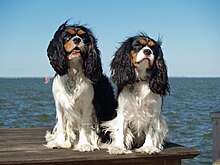
Tricolour Cavalier King Charles Spaniels

Cavalier King Charles Spaniel, Blenheim variety, with chestnut brown markings on a white background on its back, patches over eyes and all brown ears
The breed has four recognized colours. Cavaliers that take rich anecdote markings on a pearly white background are known equally Blenheim in honor of Blenheim Palace, where John Churchill, 1st Knuckles of Marlborough raised for assistance in hunting the predecessors to the Cavalier breed in this particular color. In some Blenheim dogs there is a anecdote spot in the center of the forehead: this is chosen the "Blenheim" spot.[xv] The Blenheim spot is besides known as the mark of the "Duchess Pollex Impress", based on the legend that Sarah Churchill, Duchess of Marlborough while awaiting news of her husband's safe render from the Boxing of Blenheim, pressed the head of an expecting dam with her thumb, resulting in five puppies bearing the lucky marker after news that the boxing had been won.[sixteen]
Black and Tan are dogs with black bodies with tan highlights, particularly eyebrows, cheeks, legs and beneath the tail.[17] Black and Tan is referred to as "King Charles" in the Male monarch Charles Spaniel.[8]
Crimson Cavaliers should be entirely chestnut all over,[xviii] although some tin can have some white in their coats that is considered a fault under American Kennel Club conformation show rules.[19]
The fourth colour is known as Tricolour, which is black and white with tan markings on cheeks, inside ears, on eyebrows, inside legs, and on underside of tail.[17] This color is referred to as "Prince Charles" in the Rex Charles Spaniel.[8]
-

A Cavalier King Charles Spaniel at the Musee du Louvre in Paris, France (Credit: @caviemonty).
-

Rich chestnut markings on a white pearly glaze.
-
Black-and-tan Cavalier King Charles Spaniel.
-
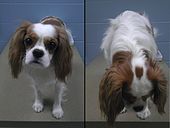
Front and top view of Blenheim Spot.
-
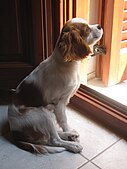
Condescending King Charles Spaniel in the window.
-
Portrait of a immature female.
-

Tri-color and Blenheim Cavalier King Charles Spaniels.
-

Condescending chewing on a wooden stick.
Popularity [edit]
According to statistics released by The Kennel Social club, Cavaliers were the 6th most popular dog in the Britain in 2007 with 11,422 registrations in a single yr. Labrador Retrievers were the most pop with 45,079 registrations in that year.[20] Their popularity is on the rise in America; in 1998 they were the 56th most pop breed but in both 2007 and 2008 they were the 25th most popular.[21] They ranked higher in some private US cities in the 2008 statistics, existence 8th in both Nashville and Minneapolis-St.Paul,[22] 7th in Boston, Atlanta[23] and Washington D.C.,[24] and 6th in both New York City[22] and San Francisco.[24] The breed's popularity has connected to grow, ranking in 18th place in 2013.[25] In 2009, the Cavalier was the 4th near popular brood in Australia with 3,196 registrations behind only Labrador Retrievers, German language Shepherd Dogs and Staffordshire Bull Terriers.[26] In addition, there are also national breed clubs in Belgium, Canada, Czech republic, Denmark, Republic of finland, France, Frg, Netherlands, New Zealand, Norway, South Africa, Spain and Sweden.[27] Today, Cavaliers are condign a popular selection in cantankerous breeding and are bred with other dogs such as poodles, though it should exist best-selling that these breeds are non purebred dogs eligible for registration under the AKC. Cavaliers have also appeared in popular culture. Cavaliers were among the pets of British Prime Minister Margaret Thatcher and U.S. President Ronald Reagan, known for his Blenheim Cavalier named Male monarch.[28] Cavaliers were also the canis familiaris of choice for Queen Victoria, as depicted in The Young Victoria starring actor Emily Blount.
Temperament [edit]
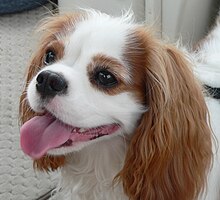
The breed is highly affectionate, playful, extremely patient and eager to delight. As such, dogs of the brood are good with children and other dogs.[ane] Cavaliers are not shy about socializing with much larger dogs.[29] They will adapt quickly to almost any environment, family, and location and suit city and country life.[one] Their ability to bond with larger and smaller dogs makes them platonic in houses with more than one breed of dog every bit long every bit the other dog is trained. Cavaliers rank 44th in Stanley Coren's The Intelligence of Dogs, beingness of average intelligence in working or obedience. Cavaliers are naturally curious and playful, only also savour simply cuddling upward on a cushion or lap, making them excellent companion or lap dogs for medical patients and the elderly.[30]
Cavaliers are active and sporting. Cavaliers are successful in conformation shows, obedience and agility and they also make wonderful therapy dogs due to their sweet, gentle natures.[1] The brood is adaptable in their need for exercise, happy with either sleeping on the couch or taking long walks.[1]

The breed is well known for its loving temperament.
They accept an instinct to chase most things that move including vehicles on busy streets, and so most Cavaliers will never go "street-wise".[31] As they tend to regard all strangers as friends, members of the breed volition usually not make good baby-sit dogs. Spaniels have a strong hunting instinct and may endanger birds and small animals. Nonetheless, owners have reported that through training their Cavaliers live happily with a multifariousness of small-scale animals including hamsters and gerbils.[32]
The Condescending's glaze requires weekly brushing, but no trimming.[one] However, some owners prefer to trim their Condescending's long feathers and slippers that can become very muddied when walking or playing outside.
Wellness [edit]
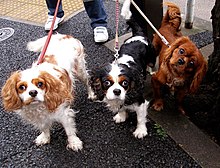
Three Cavalier King Charles Spaniels

Black-and-tan Cavalier King Charles Spaniel
Cavaliers can notably be prone to mitral valve affliction, which leads to eye failure. This appears in many Cavaliers at some signal in their lives and is the most mutual cause of death. Some serious genetic health problems, including early-onset mitral valve disease (MVD), the potentially severely painful syringomyelia (SM), hip dysplasia, luxating patellas, and sure vision and hearing disorders are wellness problems for this breed.[33] As today's Cavaliers all descend from merely six dogs, any inheritable disease present in at least one of the original founding dogs tin be passed on to a significant proportion of future generations. This is known as the founder effect and is the likely cause of the prevalence of MVD in the brood.[34] Additionally, bad breeding increases the take chances that a Condescending will develop MVD, so information technology is of import to find a responsible breeder that uses dogs with good for you hearts rather than employ the starting time breeder yous come across. The wellness problems shared with this breed include mitral valve affliction, luxating patella, and hereditary eye issues such as cataracts and retinal dysplasia.[35] Cavaliers are also afflicted by ear problems, a common health problem amid spaniels of various types, and they tin can have such other general conditions as hip dysplasia, which are common across many types of dog breeds.
In 2022, the Oslo District Court made a ruling that banned the breeding of Cavalier Rex Charles spaniels in Kingdom of norway due to their propensity for developing health problems. In its verdict the court judged that no canis familiaris of this breed could be considered healthy, therefore using them for breeding would be a violation of Kingdom of norway'southward Animal Welfare Human activity. [36]
Mitral valve disease [edit]
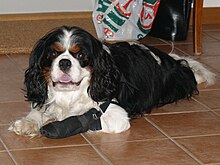
Near all Cavaliers eventually take mitral valve disease, with heart murmurs that may progressively worsen, leading to center failure. This condition is polygenic (affected past multiple genes), and therefore all lines of Cavaliers worldwide are susceptible. Information technology is the leading cause of expiry in the breed. A survey past The Kennel Club of the United Kingdom showed that 42.8% of Condescending deaths are cardiac related. The next virtually mutual causes are cancer (12.3%) and erstwhile age (12.2%).[37] The status tin can begin to emerge at an early age and statistically may be expected to be nowadays in more than one-half of all Cavalier Rex Charles Spaniels by age 5. It is rare for a ten-yr-old Cavalier non to have a center murmur. While centre disease is common in dogs generally – one in x of all dogs will eventually take heart problems – mitral valve disease is generally (as in humans) a affliction of old historic period. The "swivel" on the heart'due south mitral valve loosens and tin gradually deteriorate, along with the valve's flaps, causing a heart murmur (equally blood seeps through the valve between heartbeats) then congestive heart failure. The Cavalier is particularly susceptible to early-onset heart disease, which may be evident in dogs as young every bit one or 2 years of age.[38]
Veterinary geneticists and cardiologists have developed breeding guidelines to eliminate early-onset mitral valve disease in the breed, only information technology is unclear if a statistically significant number of breeders follow these guidelines.[39] The chairperson of the UK CKCS Guild said in 2009: "There are many members who are still not prepared to wellness check their breeding stock, and of those who do, information technology would appear that many would not hesitate to brood from affected animals."[xl] The MVD convenance protocol recommends that parents should be at least 2.5 years old and centre clear, and their parents (i.due east., the puppy'southward grandparents) should be heart clear until historic period 5.[41]
Syringomyelia [edit]
Syringomyelia (SM) is a status affecting the brain and spine, causing symptoms ranging from mild discomfort to severe pain and partial paralysis. It is caused by a malformation, commonly known as Chiari Malformation, in the lower back of the skull that reduces the space available to the brain, compressing information technology and ofttimes forcing information technology out (herniating it) through the opening into the spinal cord. This blocks the period of cerebral spinal fluid (CSF) around the encephalon and spine and increases the fluid'south pressure, creating turbulence that in plough is believed to create fluid pockets, or syrinxes (hence the term syringomyelia), in the spinal cord. Syringomyelia is rare in well-nigh breeds but has get widespread in the Cavalier Male monarch Charles Spaniel, with international inquiry samples in the by few years consistently showing over 90% of Cavaliers accept the malformation, and that betwixt 30–70% accept syrinxes.[42] However, most dogs with syrinxes are not symptomatic. Although symptoms of syringomyelia can present at whatsoever age, they typically appear between six months and four years of age in 85% of symptomatic dogs, according to Clare Rusbridge, a research scientist. Symptoms include sensitivity around the head, neck, or shoulders, ofttimes indicated by a canis familiaris whimpering or frequently scratching at the area of his neck or shoulder. Scratching is frequently unilateral – restricted to one side of the torso. Scratching motions are ofttimes performed without actually making physical contact with the body ("air scratching"). The scratching behavior appears involuntary and the dog ofttimes scratches while walking – without stopping – in a fashion that is very atypical of normal scratching ("bunny hopping"). Scratching typical of SM is usually worse when the canis familiaris is wearing a neckband, is being walked on leash, or is excited, and first thing in the forenoon or at nighttime.[43]
Non all dogs with SM show scratching beliefs. Non all dogs who testify scratching beliefs appear to be in pain, though several leading researchers, including Dr Clare Rusbridge in the Great britain and Drs Curtis Dewey and Dominic Marino in the US, believe scratching in SM cavaliers is a sign of pain and discomfort and of existing neurological impairment to the dorsal horn region of the spine. If onset is at an early historic period, a first sign may be scratching and/or rapidly appearing scoliosis. If the problem is severe, at that place is likely to be poor proprioception (awareness of body position), peculiarly with regard to the forelimbs. Clumsiness and falling results from this problem. Progression is variable though the majority of dogs showing symptoms by historic period four tend to see progression of the condition.[43]
A veterinary will dominion out basic causes of scratching or discomfort such every bit ear mites, fleas, and allergies, and so, primary secretory otitis media (PSOM – glue ear), too as spinal or limb injuries, before assuming that a Condescending has SM. PSOM can present similar symptoms but is much easier and cheaper to care for.[44] Episodic Falling Syndrome can besides present similar symptoms. An MRI scan is normally done to ostend diagnosis of SM (and also will reveal PSOM). If a veterinarian suspects SM he or she will recommend an MRI scan. Neurologists give scanned dogs a signed document noting its grade.[43]
Episodic Falling (EF) [edit]
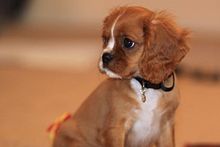
Ruby Cavalier King Charles Spaniel puppy
Episodic Falling causes "practise-induced paroxysmal hypertonicity" significant that there is increased muscle tone in the domestic dog and the muscles cannot relax. Previously thought to be a muscular disorder, it is now known to exist neurological. EF is caused by a single recessive gene, and a genetic test is available.[45] Except for severe cases, episodes volition be in response to exercise, excitement or like exertions. Although EF is frequently misdiagnosed as epilepsy, which typically results in loss of consciousness, the dog remains witting throughout the episode.[46] Severity of symptoms can range from balmy, occasional falling to freezing to seizure-like episodes lasting hours. Episodes tin can become more than or less severe as the dog gets older and there is no standard pattern to the attacks. The onset of symptoms usually occurs when a domestic dog is between 4 months and 4 years of historic period.[45] Information technology is similar to Scotty Balk, a genetic disorder in Scottish Terriers.[47] About 1% of Cavaliers are affected by the condition, with 19% being carriers. Dogs with whole coloured coats were more likely to be affected than dogs with parti-coloured coats.[48]
Thrombocytopenia and macrothrombocytopenia [edit]
Every bit many every bit one-half of all Cavalier Male monarch Charles Spaniels may have a congenital blood disorder chosen idiopathic asymptomatic thrombocytopenia, an abnormally low number of platelets in the blood, according to recent studies in Kingdom of denmark and the Usa. Platelets, or thrombocytes, are deejay-shaped blood elements thataid in claret clotting. Excessively low numbers are the most mutual cause of bleeding disorders in dogs. The platelets in the blood of many Condescending King Charles Spaniels are a combination of those of normal size for dogs and others that are abnormally oversized, or macrothrombocytes. Macrothrombocytosis besides is a congenital abnormality found in at least a third of CKCSs. These large platelets function normally, and the typical Cavalier does not appear to experience any health problems due to either the size or fewer numbers of its platelets.[49]
Hip and knee joint disorders [edit]
Hip dysplasia is a common genetic disease that affects Cavalier King Charles Spaniels. It is not present at birth but develops with age. Hip dysplasia is diagnosed by 10-rays, but it is not normally evident in X-rays of Cavaliers until they mature. Even in adult spaniels with astringent hip dysplasia, Ten-rays may not always point the illness.[50] In a series of evaluations by the Orthopedic Foundation for Animals, the Cavalier was ranked 78th worst out of 157 breeds. The worst afflicted breeds were the Bulldog, Pug and Dogue de Bordeaux.[51]
Cavaliers can be bailiwick to a genetic defect of the femur and knee chosen luxating patella. This condition is most ofttimes observed when a puppy is iv to half dozen months old. In the most serious cases, surgery may be indicated. The grading system for the patella runs from i (a tight knee), to four (a human knee then loose that its cap is easily displaced). If a condescending has a grade one–2, physical rehabilitation therapy and exercise may reduce the grading and potentially avert surgery. The grades 3–4 are most severe where surgery will most likely exist needed to correct the problem to avoid the development of arthritis and lameness in the limb.[52]
Centre problems [edit]
A disorder usually found in Cavaliers is keratoconjunctivitis sicca, colloquially known as "dry centre". The usual crusade of this condition is an autoimmune reaction against the dog's lacrimal gland (tear gland), reducing the product of tears. According to the Canine Inherited Disorders Database, the condition requires continual treatment and if untreated may result in partial or full incomprehension.[53] This disorder can subtract or heal over time.[54]
A 1999 report of Cavaliers conducted by the Canine Heart Registration Foundation showed that an boilerplate of xxx% of all Cavalier King Charles Spaniels evaluated had heart problems.[55] They include hereditary cataracts, corneal dystrophy, distichiasis, entropion, microphthalmia, progressive retinal atrophy, and retinal dysplasia.[56]
Ear disorders [edit]
Chief Secretory Otitis Media (PSOM), also known every bit glue ear, consists of a highly viscous mucus plug that fills the dog's middle ear and may cause the tympanic membrane to bulge. PSOM has been reported near exclusively in Cavaliers, and it may affect over half of them. Because the pain and other sensations in the head and cervix areas, resulting from PSOM, are like to some symptoms caused by syringomyelia (SM), some examining veterinarians take mis-diagnosed SM in Cavaliers that really take PSOM and not SM.[57]
Cavalier King Charles Spaniels may be predisposed to a form of built deafness, which is nowadays at birth, due to a lack of formation or early degeneration of receptors in the inner ear, although this is relatively rare. In addition, more recent studies have found Cavaliers that develop a progressive hearing loss, which usually begins during puppy-hood and progresses until the canis familiaris is completely deaf, usually between the ages of 3 and v years. The progressive nature of this course of deafness in Cavaliers is believed to be caused by degeneration of the hearing nerve rather than the lack of formation or early degeneration of the inner ear receptors.[58]
Urban legend [edit]

An urban legend claims that Charles 2 issued a special prescript granting King Charles Spaniels permission to enter any establishment in the United kingdom of great britain and northern ireland,[59] [60] overriding "no dog except guide dogs" rules. A variant of this myth relates specifically to the Houses of Parliament.[61] [62] This myth is sometimes instead applied to the Condescending King Charles Spaniel.[63]
The United kingdom Parliament website states: "Contrary to pop rumor, there is no Act of Parliament referring to King Charles spaniels being allowed anywhere in the Palace of Westminster. We are often asked this question and have thoroughly researched it."[61] Similarly, in that location is no proof of any such law roofing the wider UK. A spokesman for the Kennel Gild said: "This police force has been quoted from time to time. It is alleged in books that Male monarch Charles made this decree but our research hasn't tracked it downward."[59]
See also [edit]
- Companion domestic dog
- Companion Canis familiaris Group
- Toy Group
Notes [edit]
- ^ a b c d e f g h "Get to Know the Cavalier King Charles Spaniel", 'The American Kennel Club', Retrieved xx May 2014
- ^ "Cavalier King Charles Spaniel Domestic dog Breed Data". American Kennel Social club . Retrieved 30 January 2019.
- ^ D G O'Neill; D B Church building; P D McGreevy; P C Thomson; D C Brodbelt (2013). "Longevity and bloodshed of owned dogs in England" (PDF). The Veterinary Periodical. Veterinarian Journal;2013;189(three):638-643. 198 (3): 638–643. doi:10.1016/j.tvjl.2013.09.020. PMID 24206631.
- ^ Farina, William (2014). Homo Writes Canis familiaris. McFarland. p. 195. ISBN978-ane-4766-1455-7.
the Cavalier King Charles spaniel, so named later Royalist noblemen of the English Ceremonious Wars
- ^ Lambert, Cathy (2009). Getting to Know Cavaliers. Animalinfo. p. 10. ISBN978-1-921537-thirteen-iv.
a club was formed, and a name for the revived brood was chosen – "Cavalier Rex Charles Spaniel". The term 'Cavalier' refers to members of the royalist party during the English language Civil War of the mid-17th century.
- ^ Moffat (2006): p. nineteen
- ^ Lytton, Mrs. Neville (1911). Toy Dogs and Their Ancestors Including the History And Management of Toy Spaniels, Pekingese, Japanese and Pomeranians. London, England: Duckworth & Co. pp. 81–82. Retrieved 29 November 2009.
- ^ a b c d e f g Coile (2008): p. ix
- ^ Moffat (2006): p. 22
- ^ "A Potted History". The Condescending King Charles Spaniel Lodge. 2009. Retrieved 17 November 2009.
- ^ "The Kennel Club". Retrieved 26 November 2016.
- ^ Moffat (2006): p. 23
- ^ a b "Condescending King Charles Spaniel". CavalierKingCharlesSpanielClub.co.za. Archived from the original on 22 Apr 2009. Retrieved 15 November 2009.
- ^ "Cavalier Male monarch Charles Spaniel Domestic dog Breed Information". American Kennel Club.
- ^ Lambert (2008): p. 14
- ^ "The Legendary Blenheim Spot". Charming Enshroud Cavaliers. Retrieved xxx November 2013.
- ^ a b Lambert (2008): p. 15
- ^ Jeff (2008): p. 16
- ^ "AKC Come across THE BREEDS: Cavalier King Charles Spaniel". American Kennel Club. Retrieved 5 April 2010.
- ^ "2007 Acme 20 Breed Registrations". The Kennel Club. Archived from the original on 21 July 2013. Retrieved 15 November 2009.
- ^ "AKC Dog Registration Statistics". American Kennel Club . Retrieved xv November 2009.
- ^ a b "Pinnacle x Nearly Popular Breeds in the l Largest U.Due south. Cities Page 3". American Kennel Club. Archived from the original on 18 February 2015. Retrieved 17 Nov 2009.
- ^ "Acme x Most Popular Breeds in the 50 Largest U.S. Cities Page ane". American Kennel Club. Archived from the original on 18 February 2015. Retrieved 17 Nov 2009.
- ^ a b "Top ten Near Popular Breeds in the 50 Largest U.S. Cities Page 5". American Kennel Guild. Archived from the original on 18 February 2015. Retrieved 17 Nov 2009.
- ^ American Kennel Club 2013 Dog Registration Statistics Historical Comparisons & Notable Trends, The American Kennel Order, Retrieved 30 April 2014
- ^ "ANKC: National Animal Registration Assay". Australian National Kennel Club . Retrieved 5 April 2010.
- ^ "Overseas Cavalier Clubs". The Cavalier Male monarch Charles Spaniel Club. 2009. Archived from the original on 29 March 2010. Retrieved 17 November 2009.
- ^ "The Atomic number 26 Lady's Dog". National Purbreed Dog Day. 2017. Archived from the original on 28 July 2021. Retrieved 9 January 2022.
- ^ "Cavalier Rex Charles Spaniel Training and Cavalier Canis familiaris Brood Info". Puppy-Training-at-Domicile.com. Archived from the original on 9 October 2009. Retrieved 15 November 2009.
- ^ "Cavalier King Charles Spaniels". TerrificPets.com . Retrieved xv Nov 2009.
- ^ "General Information". Cavalier King Charles Spaniel Club – USA . Retrieved xv Nov 2009.
- ^ "Cavalier FAQ". Cavalier Male monarch Charles Spaniel Club – USA. Archived from the original on ix Feb 2010. Retrieved xv November 2009.
- ^ Alex., Gough (2010). Brood predispositions to illness in dogs and cats. Thomas, Alison, 1964- (second ed.). Chichester, W Sussex: Wiley-Blackwell. ISBN9781405180788. OCLC 467711662.
- ^ Coile (2008): p. 69
- ^ "Breed Profile: The English Toy Spaniel or Rex Charles Spaniel". English Toy Spaniel Social club of America. Archived from the original on 8 Dec 2009. Retrieved 22 November 2009.
- ^ "Norway bans breeding of British Bulldogs and Cavalier King Charles spaniels". The Contained. 2 Feb 2022. Retrieved 10 February 2022.
- ^ "Summary Results of the Purebred Canis familiaris Health Survey for Cavalier Male monarch Charles Spaniels" (PDF). Kennel Club/British Small Animal Veterinarian Association Scientific Committee Summary results. Archived from the original (PDF) on 24 July 2008. Retrieved 14 November 2009.
- ^ "Mitral Valve Affliction and Condescending King Charles Spaniels". CavalierHealth.org. Retrieved 14 November 2009.
- ^ "Mitral Valve Affliction Breeding Protocol for the Cavalier King Charles Spaniel". CavalierHealth.org. Retrieved 14 November 2009.
- ^ Wedderburn, Pete (27 March 2009). "Domestic dog breeders in deprival". The Daily Telegraph. Archived from the original on xiii August 2011. Retrieved v April 2010.
- ^ "Of import Findings At CKCSC, USA'S Heart Symposium" (PDF). Cavalier King Charles Spaniel Guild. Archived from the original (PDF) on 16 November 2010. Retrieved xiv November 2009.
- ^ "Syringomyelia (SM) and the Condescending Male monarch Charles Spaniel". CavalierHealth.org. Retrieved 14 Nov 2009.
- ^ a b c Rusbridge, Clare (2007). Chiari-Similar Malformation and Syringomyelia in the Cavalier Rex Charles Spaniel. Utrecht University. ISBN978-90-393-4456-9. OCLC 123300926. Archived from the original (PhD thesis) on xxx October 2009. Retrieved xiv November 2009.
- ^ "Primary Secretory Otitis Media (PSOM) in the Cavalier King Charles Spaniel". CavalierHealth.org. Retrieved fourteen Nov 2009.
- ^ a b Gill, Jennifer L.; Tsai, Kate L.; Krey, Christa; Noorai, Rooksana E.; Vanbellinghen, Jean-François; Garosi, Laurent S.; Shelton, G. Diane; Clark, Leigh Anne; Harvey, Robert J. (January 2012). "A canine BCAN microdeletion associated with episodic falling syndrome". Neurobiology of Illness. 45 (1): 130–136. doi:10.1016/j.nbd.2011.07.014. PMC3898273. PMID 21821125.
- ^ "Episodic Falling Syndrome (Muscle Hypertonicity): Cavaliers Collapse Suddenly Afterwards Do". CavalierHealth.org. Retrieved 14 November 2009.
- ^ Slatter, Douglas H. (ane January 2003). Textbook of Small Creature Surgery (tertiary ed.). Due west.B. Saunders Visitor. p. 1094. ISBN978-0-7216-8607-3.
- ^ "Frequency of 2 disease-associated mutations in Cavalier Male monarch Charles Spaniels" (PDF). Brute Wellness Trust. Retrieved 28 June 2012.
- ^ "Blood Platelets in Cavaliers: As well Few (Thrombocytopenia) and Too Large (Macrothrombocytopenia)". CavalierHealth.org. Retrieved fourteen November 2009.
- ^ "Hip Dysplasia in Cavaliers: Painful and Expensive". Cavalier Health.org. Retrieved 5 April 2010.
- ^ "Hip Dysplasia Statistics". Orthopedic Foundation for Animals. Archived from the original on 10 Feb 2010. Retrieved 5 April 2010.
- ^ "Patellar Luxation in Cavaliers: Genetic and Degenerative". Cavalier Health.org. Retrieved 5 April 2010.
- ^ "Dry out Centre Syndrome: A Life-Long Irritating Defect for Cavaliers". CavalierHealth.org. Retrieved 14 November 2009.
- ^ "What is keratoconjunctivitis sicca (KCS)?". Canine Inherited Disorders Database. xi May 2000. Retrieved 14 November 2009.
- ^ Wheeler, Cynthia A. (1999). Ocular Disorders Presumed to be Inherited in Purebred Dogs. American College of Veterinary Ophthalmologists. ISBN978-0-9635163-2-ix.
- ^ "Corneal Dystrophy and the Cavalier King Charles Spaniel". CavalierHealth.org. Retrieved 14 November 2009.
- ^ "Principal Secretory Otitis Media (PSOM) in the Cavalier Male monarch Charles Spaniel". CavalierHealth.org. Retrieved 14 November 2009.
- ^ "Deafness in Cavalier Rex Charles Spaniels can be Congenital or Progressive". CavalierHealth.org. Retrieved 14 November 2009.
- ^ a b "Shops centre ban for 'purple' dog". Manchester Evening News (Jan 2007) . Retrieved 29 May 2016.
- ^ "King Charles and a point of law". Dogcast Radio.
- ^ a b "I want the act proverb that Male monarch Charles spaniels have special rights in the Houses of Parliament". Parliament.u.k.. Archived from the original on 4 May 2016. Retrieved 29 May 2016.
- ^ "Feeding your modest breed puppy". Kennel Gild. Archived from the original on 30 June 2016. Retrieved 29 May 2016.
- ^ Pet, Garden. "The Condescending king Charles Spaniel total Contour". Pet Garden.
References [edit]
- "AKC Run into THE BREEDS: Cavalier Male monarch Charles Spaniel". American Kennel Order. Retrieved 5 April 2010.
- "AKC Canis familiaris Registration Statistics". American Kennel Guild . Retrieved 15 November 2009.
- "A Potted History". The Cavalier King Charles Spaniel Order. 2009. Retrieved 17 November 2009.
- "Condescending King Charles Spaniel". CavalierKingCharlesSpanielClub.co.za. Archived from the original on 22 April 2009. Retrieved xv November 2009.
- Coile, D. Caroline (2008). Cavalier King Charles Spaniels (2d ed.). Barron's Educational Series. ISBN978-0-7641-3771-six.
- "Cavalier King Charles Spaniels". Blenheim Company . Retrieved fifteen November 2009.
- Dupre, Malcolm. "Cavalier King Charles Spaniel History". Barkbytes.com. Retrieved xiv Nov 2009.
- Lambert, Cathy (2008). Getting to Know Cavaliers. AnimalInfo Publications. ISBN978-i-921537-thirteen-4.
- "2007 Superlative 20 Breed Registrations". The Kennel Society. Archived from the original on 21 July 2013. Retrieved 15 November 2009.
- Lytton, Mrs. Neville (1911). Toy Dogs and Their Ancestors Including the History And Management of Toy Spaniels, Pekingese, Japanese and Pomeranians. London, England: Duckworth & Co. pp. 81–82. Retrieved 29 November 2009.
- Moffat, Norma (2006). Cavalier King Charles Spaniel: Your Happy Healthy Pet (second ed.). John Wiley & Sons. ISBN978-0-471-74823-6.
- Wheeler, Cynthia A. (1999). Ocular Disorders Presumed to be Inherited in Purebred Dogs. American College of Veterinary Ophthalmologists. ISBN978-0-9635163-two-9.
- Youatt, William (1852). The Dog. Blanchard and Lea.
External links [edit]
- Condescending Male monarch Charles Spaniel at Curlie
Source: https://en.wikipedia.org/wiki/Cavalier_King_Charles_Spaniel


0 Response to "Brown and White Baby King Charles Spaniel Coloring Pages That You Can Color"
Enregistrer un commentaire